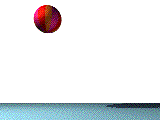Bouncing Ball Animation In Maya Pdf
Go beyond the bouncing ball by learning to express different weights. Bring your work to life with the latest Maya Animation Tutorials and Training. Animate and Rig a. Keyframe Animation—Bouncing a Ball No matter where you study animation, you’ll always fi nd the classic animation exercise. To use Maya’s Graph Editor. You can create squash and stretch effects with the squash deformer. This example shows how you can set up a ball for a bouncing ball animation.

Squashing a sphere onto the ground By default, Maya places nonlinear deformer handles at the center of the object to be deformed. For instance, when you create a sphere and create a squash deformer for it, Maya places the squash deformer handle at the center of the sphere. The deformation will be relative to the sphere’s center. If you want to squash the sphere against the ground, you can adjust the squash deformer’s attributes and move the squash deformer handle so that the deformation will be relative to where the sphere touches the ground.
In general, you can make these adjustments so that the squashing effect can occur relative to any location inside or outside of the sphere. To set up the sphere and the deformer • Create a primitive NURBS sphere. • Press the 3 number key to increase the display resolution. • Move the sphere so that it is sitting on the grid in a perspective view. You can create squash and stretch effects with the squash deformer. This example shows how you can set up a ball for a bouncing ball animation.
To create NURBS sphere with squash control • Do the previous example. • Set squash1’s Factor attribute back to 0. To create deformer for stretch control • Create another squash deformer for the sphere to provide stretch control.
Use the default creation options. The squash1 deformer provides the squashing that occurs when the ball lands on the ground. The deformer you’ve just created (squash2) will provide the stretching that will occur when the ball is in flight. To define the ball • Group the sphere (nurbsSphere1) and the deformer handles (squash1Handle and squash2Handle). • Rename the group ball.
• Open the Channel Control window (), and make the following attributes Non Keyable: • scaleX, scaleY, scaleZ • visibility The Channel Box now lists only the following keyable attributes for ball: Translate X, Translate Y, Translate Z, Rotate X, Rotate Y, and Rotate Z. • Close the Channel Control window. Now you will add two attributes to the ball for squashing and stretching. Emc Unisphere Client Software.
• With the ball selected, select. • Add a keyable attribute called flyStretch, with the following Min/Max Values: Minimum 0, Maximum 10, Default 0. • Add a keyable attribute called landSquash, with the following Min/Max Values: Minimum 0, Maximum 10, Default 0. • Close the Add Attribute window. To set driver and driven keys for stretching • Open the Set Driven Key window ( Animate >Set Driven Key >Set >). • Load ball as driver, select flyStretch attribute, and set the attribute to 0.
• Load squash2 as driven, select factor attribute, and set the attribute to 0. • Set ball’s flyStretch attribute to 10. • Set squash2’s factor attribute at 0.6. To set driver and driven keys for squashing • Open the Set Driven Key window if it is not already opened. • Load ball as driver, select landSquash attribute, and set the attribute to 0.
• Load squash1 as driven, select factor attribute, and set the attribute to 0. • Set ball’s landSquash attribute to 10. • Set squash1’s factor attribute at -2.
• Click Close to close the editor. Now the ball is ready for a bouncing ball animation with squash and stretch effects.
Description Throughout these lessons, we'll explore modeling, rigging and animating a bouncing ball. We'll cover rigging rationales and methods for rigging two distinct types of balls. We'll discuss methods of animating these balls naturally and as distinct characters in and of themselves. This course discusses music as a starting point for timing and presents methods for executing a short animation. The course concludes by discussing lighting and rendering techniques applicable to enhance the storyline. Software required: Maya 2016.